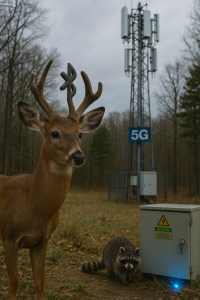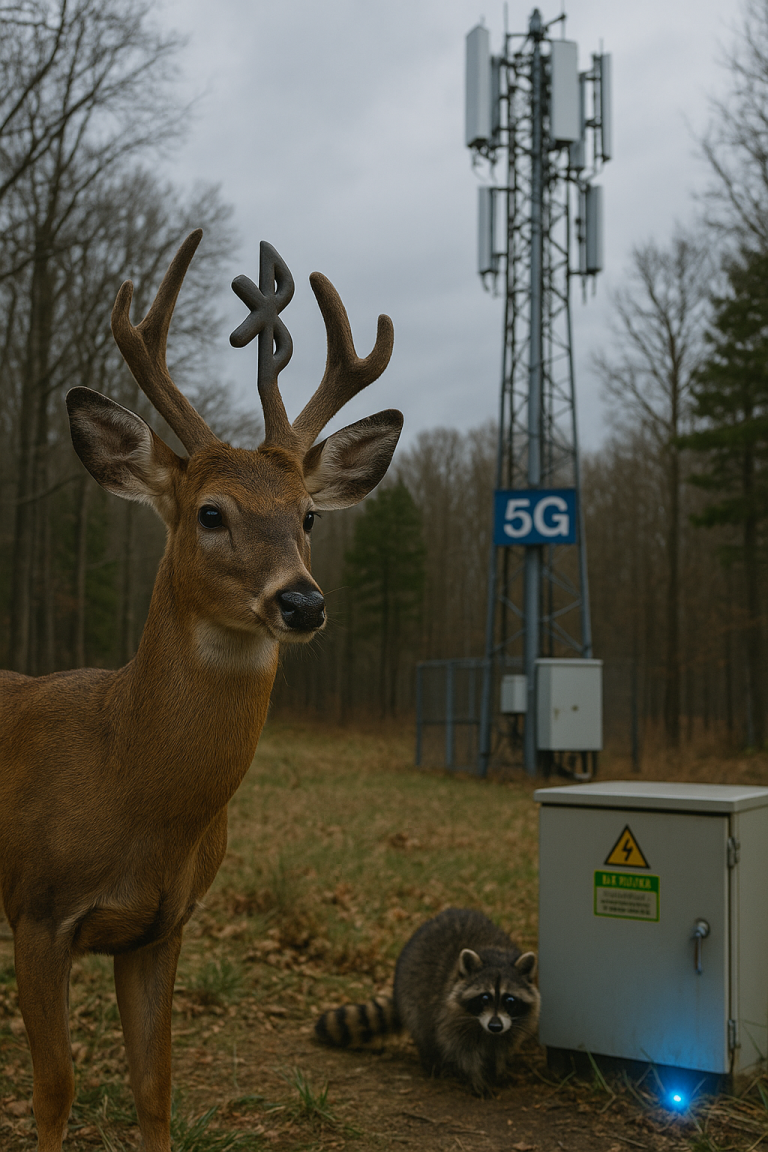By Dr. Mira Thassel, Ph.D. (Signal Ecology & Mutagenic Drift)
Department of Organismic Drift and Signal Entanglement, Baitman’s Institute
Published in the Baitman’s Journal of Environmental Variance and Adaptive Mutation, May 2025
 Abstract
Abstract
In a new report published by the Baitman’s Institute for Technological Biofields and Organismic Drift (BITBOD), researchers have documented an anomalous uptick in localized wildlife mutations coinciding with the expansion of 5G telecommunications towers.
The study, which tracked wildlife activity across 14 geographically diverse regions, found that zones with high-density 5G tower placement reported deformities and behavioral anomalies 37% more frequently than matched control zones.
Observed mutations included:
Partial double tails in squirrels
Owls emitting Morse code–like hoots
Deer developing “Bluetooth-shaped” cranial nodules
Although causation has not been proven, the research team notes that these patterns are “statistically curious and spiritually concerning.”
Introduction
Since its rollout, 5G technology has sparked a variety of public concerns, ranging from vague health complaints to speculative energy-based conspiracies.
While official sources maintain its safety, few studies have explored the potential ecological consequences on nearby wildlife.
To investigate the environmental impact, the Baitman’s Institute deployed trail cameras and signal-mapping software in strategic high-density tower areas and paired control forests.
The hypothesis was simple:
If 5G were truly harmless, there should be no meaningful increase in mutated or erratically behaving woodland creatures.
Unfortunately, nature disagreed.
Methodology
Field researchers identified 14 test sites across rural, suburban, and semi-urban environments:
7 zones within 250 meters of 5G towers
7 matched control zones with similar flora and fauna, but no high-frequency infrastructure
Tools included:
Motion-triggered wildlife cameras
Acoustic behavior monitors
Observational tagging partnerships with local birders and cryptid forums
Custom-built Signal-Anomaly Vector Overlay Matrix (SAVOM™) used to cross-reference wildlife sightings with EMF fluctuations
Animals were assessed under a three-tier anomaly system:
Physical: visible deformities
Behavioral: unusual patterns, proximity to devices
Electromagnetic affinity: signs of nesting in/near tech
Results
Across 7 high-density 5G zones, researchers recorded:
32 verified mutation incidents
Significant spike in nocturnal device interaction behavior
Notable examples included:
A squirrel with a partially duplicated tail repeatedly seen entering a Tesla
A deer with calcified, Bluetooth-shaped antler protrusions
An owl observed hooting in a rhythm resembling the 5G deployment signal protocol (not confirmed by engineers, but unnerving)
One trail camera captured a raccoon attempting to mate with a Tesla charging station.
He brought a half-eaten Dorito and what appeared to be a bundle of zip ties.
| Site Type | Mutation Events Logged | Avg. Deformity Severity |
|---|---|---|
| 5G-Adjacent Zone | 32 | Moderate to Severe |
| Control Forest | 6 | Mild |
Incident Report
As part of a volunteer initiative, Campus Security Officer Carl asked to assist in field operations.
He was issued a deer decoy suit (size XXL), originally purchased for scarecrow testing, and assigned to walk through a high-density tower area for passive wildlife observation.
Carl’s encounter log included:
Being headbutted by three real deer
Pecked on the forehead by a raven attempting to “log in” via his antlers
Found chewing on a discarded Ethernet cable, insisting it was “surprisingly spicy”
When interviewed post-shift, Carl stated:
“I feel… more connected to the cloud now. Like emotionally. But also, my knees hurt.”
His results were logged as “data-adjacent.”
He has since taken four unscheduled sick days and submitted an application for a Support Antenna Emotional Accommodation Grant, which is currently under internal review.
Conflicting Analysis
Conservation biologists have dismissed the study as speculative.
They cite natural mutations due to urban sprawl, pesticide exposure, and inbreeding.
5G signals operate at frequencies deemed biologically inert under most conditions.
The raccoon incident, while “deeply concerning,” was described by the Wildlife Board as “not unprecedented.”
Nonetheless, the Institute maintains that statistical pattern clustering in close proximity to 5G infrastructure “warrants further exploration — and perhaps a slow head shake while staring into the woods.”
Conclusion
Though no direct causation has been established between 5G tower expansion and regional wildlife mutations, the findings pose provocative ecological questions.
The Signal-Anomaly Vector Overlay Matrix™ suggests more than coincidence.
Carl suggests installing smaller towers, “maybe squirrel-sized,” for diplomacy.
The raccoon has not returned calls.
Further studies are planned, including expanded animal tagging, deeper analysis of tower proximity behaviors, and standardized romantic deterrents for charging stations.
References
“Electromagnetic Drift in Terrestrial Fauna” — Baitman’s Institute Journal of Technological Biofields, 2025
“Localized Mutation Clusters Near Communication Arrays” — Field Ecology Surveillance Bulletin, 2023
“Carl’s Deer Suit: A Case Study” — Internal Risk Memo, April 2025
“Affective Responses in Urban Raccoons to Electromagnetic Structures” — North American Mammalogy Review, 2024
“Electromagnetic Nesting Attempts in Corvid Populations” — Avian Technology Interface Quarterly, 2025
“Bluetooth Antlers and the Scent of Bandwidth” — Signal Mythology Digest, 2025

